AI at Work
5 Impactful Blog Post Examples and Using AI to Create Them

Akshita Sharma · Content Marketing Associate
February 4th, 2025 · 15 min read

Maintaining a consistent flow of engaging blog content is an ongoing challenge for marketers. The traditional content creation workflow—from ideation through research, planning, content development, and SEO optimization—demands significant bandwidth from marketing teams. As a result, many teams find themselves caught between demanding content schedules and maintaining quality standards, leading to missed deadlines and content that underperforms against both engagement metrics and search visibility goals.
Typeface's enterprise-grade AI content platform fundamentally transforms this equation. By automating up to 70% of the content creation process—from keyword research and optimization, outline generation to creating complete first drafts—marketing teams can redirect their expertise to strategic refinement. This allows teams to scale their blog production from 3-4 posts monthly to 10-12 posts, while maintaining a consistent brand voice.
In this article, we will take a look at some examples of impactful blog posts to inspire you. We will also show you how Typeface’s AI capabilities can help improve your blog content creation strategy.
The benefits of using AI to write blogs
5 blog post examples to inspire you
How to use AI blog post generator to create these blogs?

The benefits of using AI to write blogs
According to a CMI survey, blogs are the most frequently used type of content by marketers for demand generation.
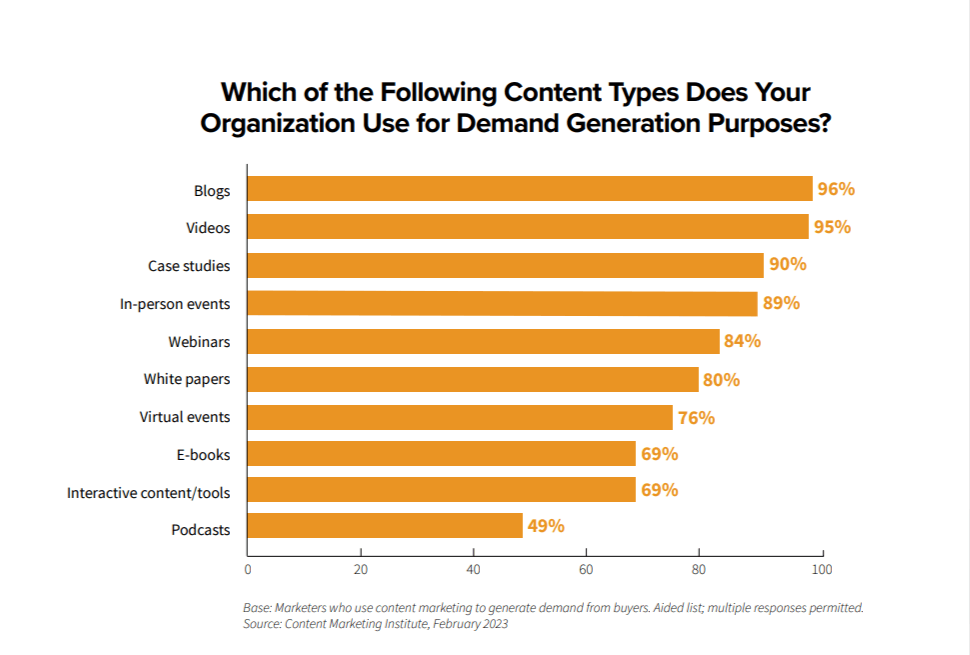
Strategic blog marketing can deliver measurable value across multiple vectors: enhanced organic traffic acquisition, strengthened market positioning, and elevated brand authority. This translates directly into measurable ROI through sustained audience growth and increased customer lifetime value.
However, creating impactful blogs that truly resonate and align with your company's goals demands a thoughtful approach. It requires a solid blog marketing strategy that focuses on SEO, understanding your audience, and effectively using AI for generating blog content. Modern AI systems can be invaluable in executing this strategy, as they help create engaging content that aligns with SEO goals, audience preferences, and your own brand guidelines.
Typeface is one such AI content platform that distinguishes itself through audience-centric content generation and advanced brand voice preservation capabilities. With the SEO Blog Post template, you can get suggestions for relevant keywords, generate content outlines, and get complete first drafts based on the provided inputs. This allows you to focus on refining the content and adding your unique insights, rather than starting from scratch every time.

Another advantage of using this AI content platform is its ability to optimize content for SEO. Typeface's AI can suggest region-specific keywords and phrases that will help your blog posts rank higher in search results. As it generates the blog, it seamlessly incorporates these keywords into the content. The platform also comes with AI features for content optimization, like "Improve SEO," “SEO blog template,” and "SEO meta tags." To edit and refine your text, there's Generative Refine tool that can help in polishing or reworking the content.
Check out this blog on How to Use an AI Blog Post Generator to learn more about using this AI for blog generation.
Now, if you're looking for some blog post examples to guide you in your blog creation process, we've compiled some to help spark your creativity and provide some inspiration.
5 blog post examples to inspire you
To help you get started, here are some blog post examples that can inspire your content creation process. Each blog writing example covers a different blog writing format and can be tailored to fit your brand's goals and audience.
1. How-to blog post example
How-to posts are great for traffic generation and customer education because they provide practical, actionable advice for solving your customers' most urgent problems. They are usually created for guiding your readers through a process or teaching them how to accomplish a specific task.
Here are some key elements that should be present in a well-crafted how-to blog post:
Clearly defines the specific goal or task
Provides sufficient context before tactical guidance
Organizes steps in a logical sequence
Includes visuals or diagrams to enhance understanding
Ends with additional tips or suggestions for further exploration
This blog from Squarespace is an excellent example of an effective how-to guide. The post demonstrates an understanding of its target audience, speaking directly to potential travel bloggers, addressing their likely questions, concerns, and motivations. It opens with the potential benefits of creating travel blogs (attracting an audience, building reputation, potentially earning money), immediately creating value and motivating readers to continue reading.
The article then breaks down the complex process of creating a blog into eight manageable steps. Each step builds logically on the previous one, guiding readers from the initial concept to full implementation. This step-by-step approach prevents readers from feeling overwhelmed and provides a clear path forward.
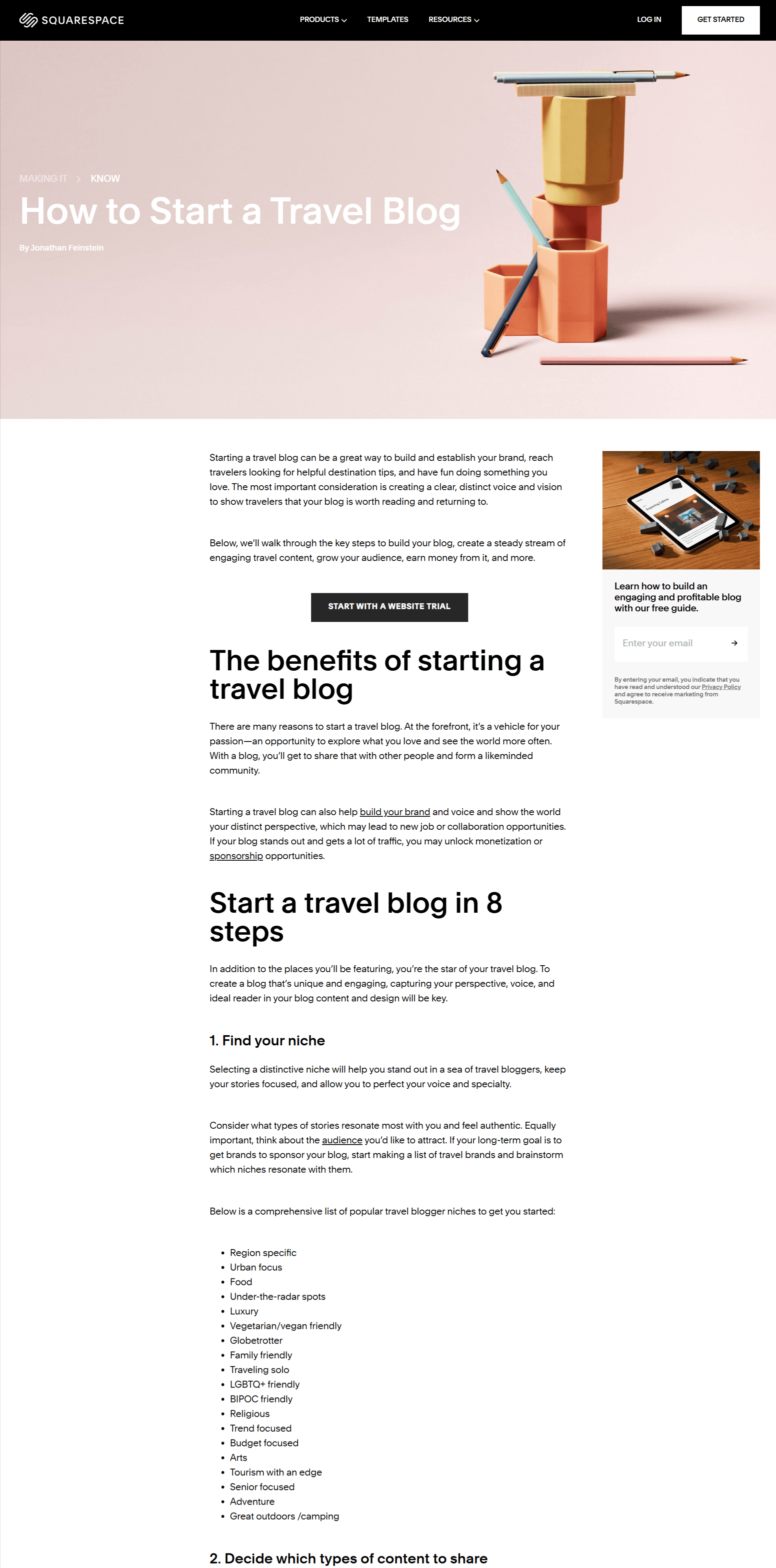
What makes this how-to blog particularly effective is its ability to balance educational content with subtle promotion. While clearly a Squarespace marketing piece, it provides genuine value to the reader. The promotional elements feel like helpful recommendations rather than pushy sales tactics. The blog also links to other valuable Squarespace resources to improve understanding, while improving the page’s SEO. As for the CTAs, the post uses multiple strategic, contextual CTAs, subtly guiding readers to try Squarespace for building their travel website.
2. Listicle post example
Listicle blog posts are a favorite among people. Their scannable format aligns perfectly with modern audiences' browsing habits, leading to longer time-on-page and higher engagement rates. They work especially well for sharing tips, ranking items, or compiling favorite resources. So, whether you're looking to entertain, inform, or persuade, listicles offer a versatile way to engage your audience.
Here are some key elements that should be present in a well-crafted listicle:
A catchy headline (featuring a number) optimized to increase clicks
Brief introduction that outlines the purpose of the list
Clear and concise points or list if items, each paired with a short description
Visual elements like infographics, charts, or branded images to boost social sharing
This blog piece from the haircare brand, OUAI, is a quintessential example of a listicle engineered for maximum reader engagement. It begins with a compelling, number-driven headline "The 6 Best Brushes For an At-Home Blowout" that quickly communicates what the content promises.
Each brush recommendation follows a reader-friendly format that makes the content scannable. For each product, the writer includes three key sections: appropriate hair type, recommended hair length, and why it's great for home use. This helps readers quickly determine if a recommendation applies to them.
The product images of the different hairbrushes are clear, well-lit, and provide a tangible visual reference to accompany the written descriptions. The listicle also brilliantly incorporates credibility by including specific tips from professional hairstylists.

Moreover, the article subtly addresses potential reader objections by including practical tips with each recommendation. These aren't just product descriptions but mini tutorials that make readers feel more confident about purchasing the brush.
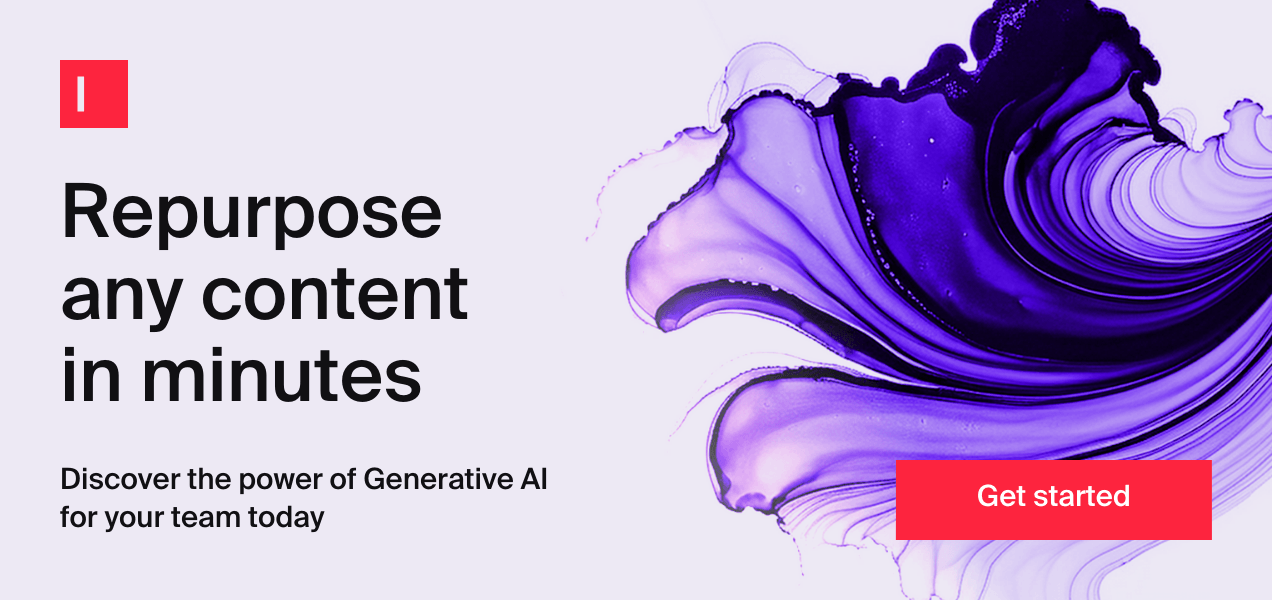
3. Case study post example
Case studies are bottom-of-funnel content pieces that showcase real-life examples of how your product or service has helped customers achieve their goals. They typically follow a structured format that involves identifying the challenges that your customers faced, the solutions that were implemented, and the results or outcomes of these efforts. When prospective clients see tangible evidence of your product or service benefiting others similar to themselves, they are more likely to feel confident in choosing your company to meet their needs.
Here are some key elements that should be present in a well-crafted case study post:
Background information on the case study topic
Detailed explanations of the actions implemented
Supporting data demonstrating outcomes and impact
Lessons learned and suggested recommendations
Here’s a case study from Stripe. It is an excellent example of a middle or bottom-of-funnel case study that is clearly aimed at prospects in the consideration/decision stage. The primary goal appears to be converting prospects who are in the final stages of vendor selection by providing concrete evidence of successful implementation.
The case study follows the classic problem-solution-results framework, making it easy for readers to follow the narrative. The clean, professional layout and the strategic use of white space helps in enhancing readability. It also uses visual hierarchy to highlight key metrics and outcomes.
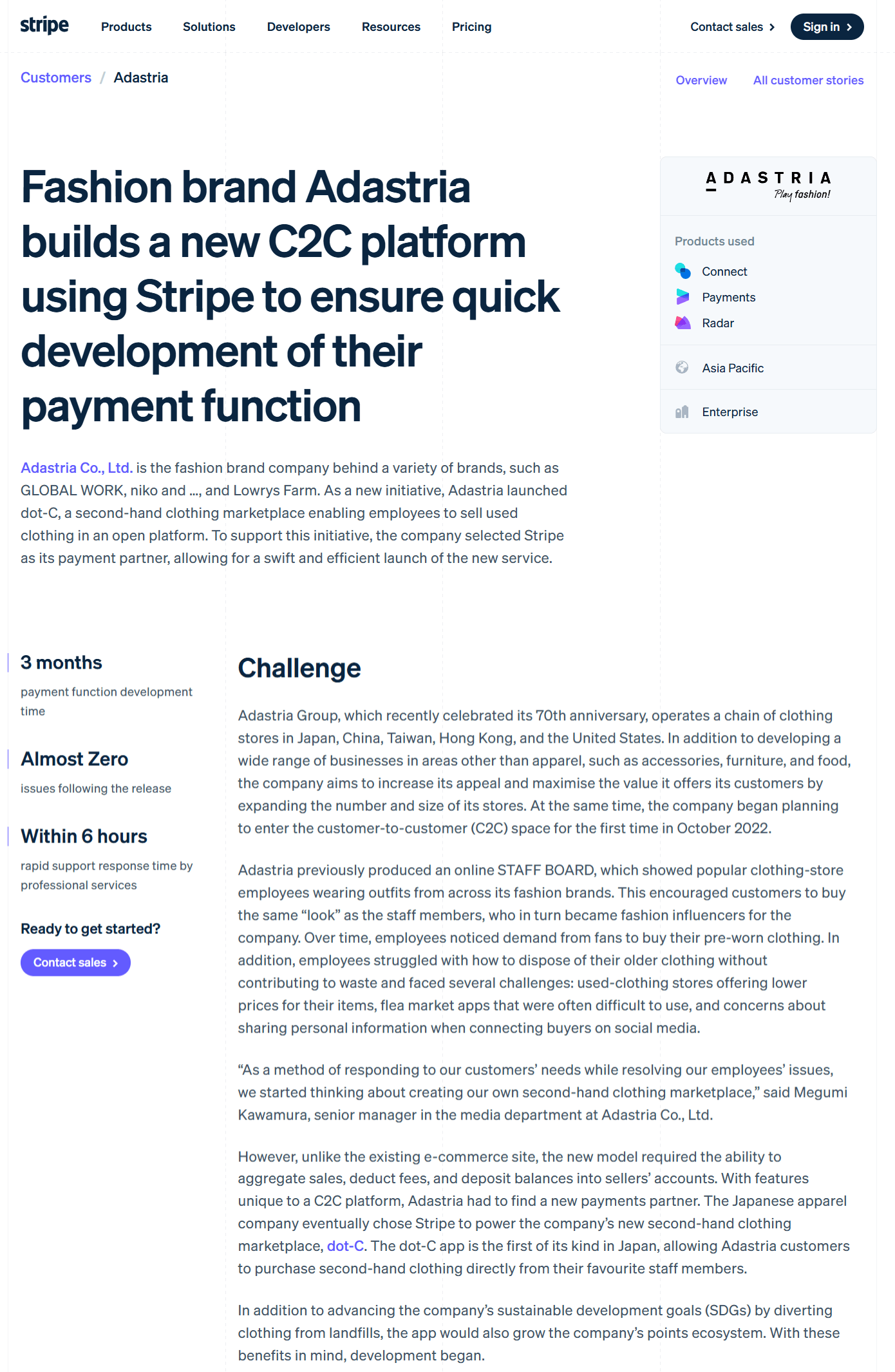
The great thing about this case study is that it leads with tangible business outcomes first, not technical details. Each section builds naturally on the previous one and it maintains focus on the customer's journey rather than just product features. The case study also features direct quotes from Adastria's team members, which helps in building credibility. At the bottom of the page, it includes related case studies to encourage readers to check out other ways the brand has helped its clients achieve their business goals.
This case study is a good example because it doesn't just tell a story - it builds a compelling case while addressing common objections and concerns that potential customers might have.
4. Opinion blog post example
Opinion posts allow you to share your thoughts and perspectives on industry trends, news, or other relevant topics. They are great for top-of-funnel content, designed primarily for awareness and thought leadership. When done right, they spark conversations, challenge assumptions, and position you as the go-to voice in your space.
Here are some key elements that should be present in a well-crafted opinion blog post:
A bold opener that plants your flag and tells readers exactly where you stand from the start
Real-world examples, data points, and stories that make your argument impossible to ignore
Section(s) tackling potential counterarguments
Clear next steps for readers to keep the conversation going
This blog from Amica Insurance is a well-crafted opinion blog post that effectively showcases the key elements of this format. The title "Company Life Insurance Coverage: Is It Enough?" immediately plants the flag and lets readers know the author's stance - that there are important considerations around the adequacy of company-provided life insurance coverage.
The post anticipates potential objections or questions readers may have and addresses the "upsides" and "downsides" of employer-provided life insurance. This helps create a balanced, nuanced perspective.
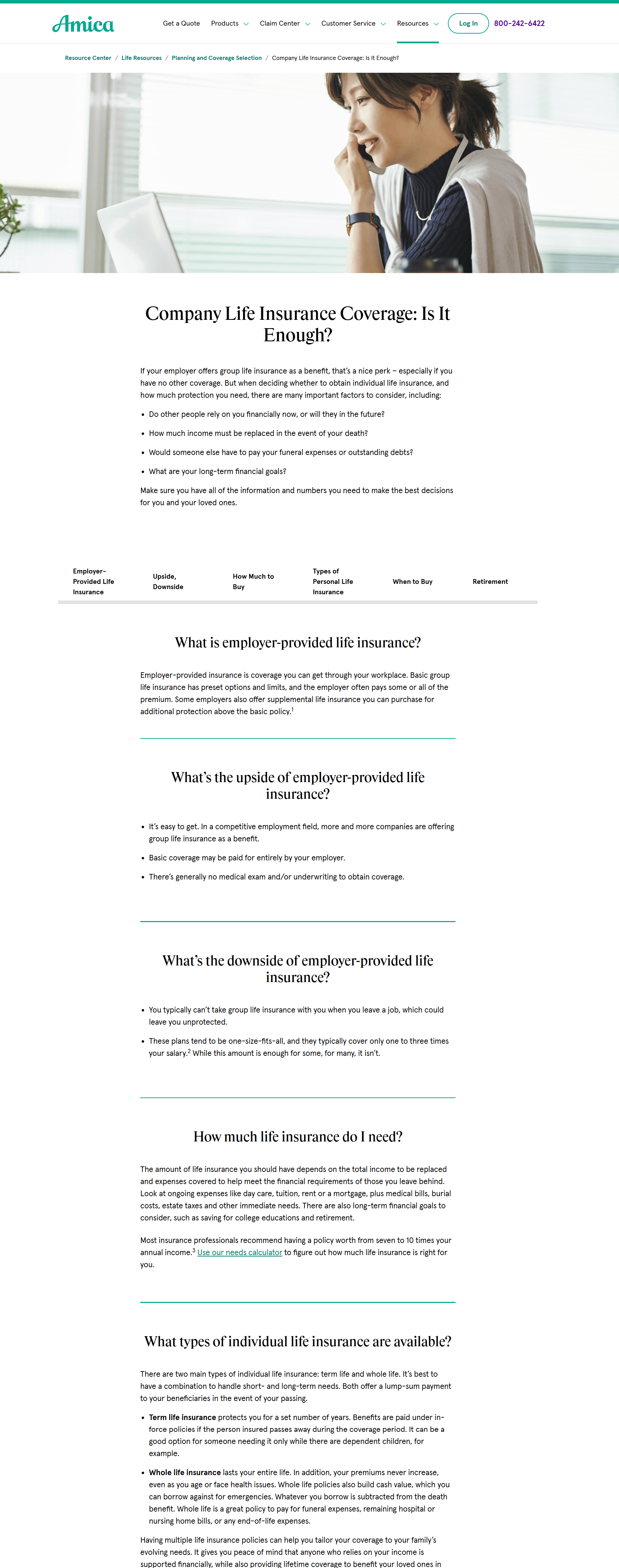
The post includes clear next steps for readers, like prompting them to "get a life insurance quote today" and providing a call-to-action button to do so. This keeps the conversation going and provides a logical next step.
Overall, the content is well-structured, informative, and written in a tone that feels authoritative yet approachable. This type of thought leadership content is an excellent way to raise awareness, build trust, and nurture leads at the top of the marketing funnel.
5. News and trends type post example
News and trends posts cover recent developments, upcoming events, or emerging technologies. Creating these types of blog posts isn't just about information sharing – it's about positioning your brand as a thought leader and trusted advisor in your space. When you consistently deliver insights on market developments, technology advances, and shifting consumer behaviors, you can build loyalty and trust with your readers, who will start to depend on you for insightful and timely updates about your industry or global events.
Here are some key elements that should be present in a well-crafted news and trends type post:
Topics that are both timely and newsworthy
Actionable insights backed by current market research and data visualizations
Expert perspectives from industry leaders and market analysts
Clear recommendations that readers can implement immediately
Visual storytelling through infographics, charts, and trend graphs
This Shopify blog post is an excellent example of a news and trends-style article. The core focus - understanding how influencer pricing is expected to change by 2025 - is undoubtedly a timely and relevant topic for brands using Shopify.
The article starts by highlighting the growing importance of influencer marketing, which sets the stage for the core focus of the piece. It then breaks down the typical pricing tiers across the major social platforms - Instagram, TikTok, and YouTube - giving readers a clear sense of what nano, micro, mid-tier, macro, and mega influencers tend to charge. This level of specificity is invaluable, allowing brands to benchmark costs and plan their influencer budgets accordingly.

Beyond just the pricing data, the article also covers important factors that can influence an influencer's rates. The article even provides a handy formula for assessing an influencer's value.
Throughout the content, the writing style is clear, accessible, and highly informative. The author does an excellent job of breaking down complex topics, providing relevant examples, and offering actionable recommendations.
How to use AI blog post generator to create these blogs?
Typeface's enterprise AI solution simplifies traditional content workflows by automating high-effort, low-strategy tasks in the blog creation process. This quick guide will show you how to use Typeface's AI capabilities to streamline content creation for multiple blog formats, including product insight pieces, technical deep-dives, case studies and any others.
Step 1. Prepare your inputs: Before you start using Typeface for writing blog posts, it's important to do some preliminary research and organize your input information.
Choose your topic and format: Map content objectives to specific business KPIs (lead generation, thought leadership, market education) and choose a topic and blog format accordingly.
Keyword research: Research relevant, high-volume keywords or use Typeface to suggest keywords based on your topic or existing content
Audience research: Research your audiences' demographics and preferences so you can personalize the content to address their concerns and queries.
Content research: Gather relevant case studies, proprietary research, industry reports and other documents related to your topic to provide the AI with relevant context.
Step 2. Provide inputs to the AI blog post generator
Input details: In the Typeface "SEO Blog Post" template, enter the topic and the keywords you've researched.
Set preferences: Choose the target country and relevant primary and secondary keywords for your blog.
Add supporting documents: Upload relevant documents that the AI can use to enrich the content.
Generate outline: Once you've provided all your inputs, generate the outline.
Step 3. Review and edit AI-generated content
Outline review: Go through the AI-generated outline and incorporate competitive insights and relevant FAQs from Typeface’s “Explain” panel.
Generate and edit content: Once satisfied with the outline, have the AI generate the first draft. Edit for accuracy, add your unique insights, and ensure alignment with brand guidelines.
Finalize visuals: Add appropriate visuals throughout the text. Use Typeface's AI Image Studio to generate these visuals.
By following these steps, you can produce blog content faster and invest more time on creativity and strategic content planning.
Enhance your blog writing strategy with AI
AI blog post generators offer numerous benefits, including personalized content creation, SEO optimization, and time-saving features. Typeface's enterprise AI platform enables marketing teams to:
Generate consistent, brand-aligned content for global markets
Reduce content production cycles from weeks to days
Seamlessly repurpose cornerstone content into multiple formats for omnichannel deployment
Drive measurable improvements in engagement and conversion metrics
For example, A Fortune 500 energy management company was able to increase blog engagement by 65% by using Typeface to generate AI-assisted blog posts. To see an improvement in your own engagement rates, consider signing up for a 30-day free trial of Typeface today. You can also schedule a demo to learn how to make the most of this AI content platform for blog content creation.

Share
Related articles

AI at Work
25+ AI Blog Prompts to Write Blog Posts Faster

Akshita Sharma · Content Marketing Associate
July 25th, 2025 · 16 min read

AI at Work
How to Use an AI Blog Post Generator to Write a Blog Post in Less Than an Hour

Akshita Sharma · Content Marketing Associate
December 3rd, 2024 · 11 min read

AI at Work
Typeface on Typeface: How I Uplevel Abstract AI Designs for Blogs and Webpages

Ananya Mohan · Visual Designer
June 12th, 2024 · 5 min read
